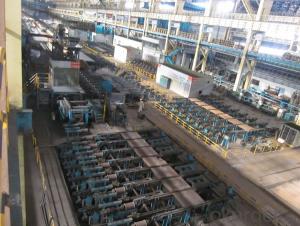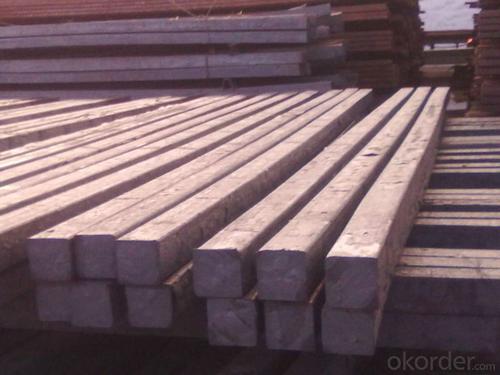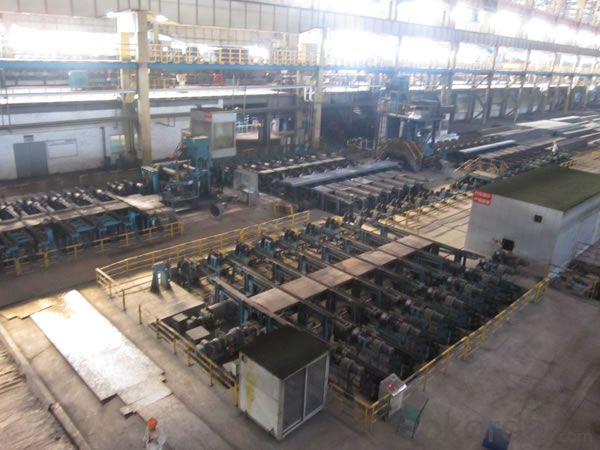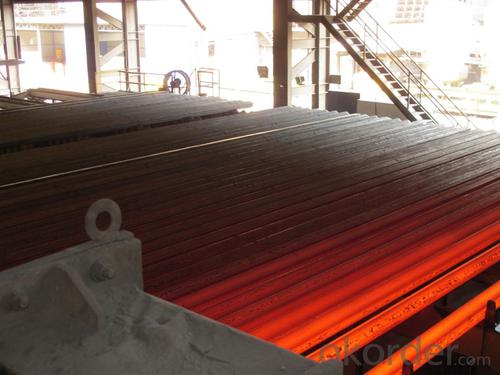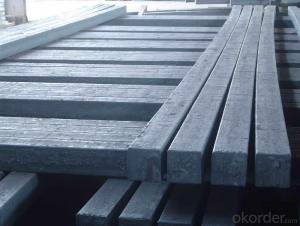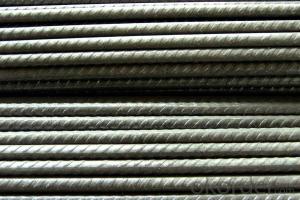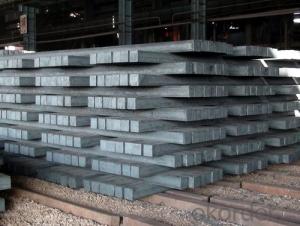Square Steel Billet Q235 3SP Grade Prime Quality 5#
- Loading Port:
- Tianjin
- Payment Terms:
- TT OR LC
- Min Order Qty:
- 2000 m.t
- Supply Capability:
- 50000 m.t/month
OKorder Service Pledge
OKorder Financial Service
You Might Also Like
Description of Square Steel Billet Q235 Grade Prime Quality 5#
M. S. Billets are used for rolling of TMT Re-Bars of Fe415 and Fe500 Grade and various other structural steel products.
CRS Billets are used for rolling of CRS TMT Re-Bars.
Special Alloy Billets are used for rolling of any special grade TMT Re-Bars like Earthquake resistant TMT Re-Bars and for special grade structural steel products.

Main Feature Square Steel Billet Q235 Grade Prime Quality 5#
Raw elements(C,Fe,Ni,Mn,Cr,Cu.)---Smelted ingots by AOD finery---hot rolled into black suface---pickling in acid liquid---cold drawn----polished by automatically machine--- cutting into pieces---checking quanlity
Applications of Square Steel Billet Q235 Grade Prime Quality 5#
Widely Used in the areas such as Stainless Steel Fasteners, Chains, Kitchen and Sanitary wares, Furniture handles, Handrails, Electroplating and Electrolyzing pendants, Foods, Electron, Petroleum, Construction and Decoration, etc. Products have a high strength after cold-working. Electronic products parts, Medical appliance, Springs, Bus Inside and Outside packaging and building, Street Lamp Posts, etc. Decoration materials and Outdoor Publicity Billboard. Used for the products which have the Anti-Stress Corrosion requirement. Electron Products, Table-wares, Bolts, Nuts, Screen Meshes, Cumbustors and so on.

Specifications of Square Steel Billet Q235 Grade Prime Quality 5#
| Standard | C(%) | Mn(%) | S(%) | P(%) | Si(%) |
| Q195 | ≤0.12 | ≤0.50 | ≤0.040 | ≤0.035 | ≤0.30 |
| Q235 | ≤0.20 | ≤1.40 | ≤0.045 | ≤0.045 | ≤0.35 |
| Q275 | ≤0.22 | ≤1.50 | ≤0.045 | ≤0.045 | ≤0.35 |
| 20MnSi | 0.17-0.25 | 1.2-1.6 | ≤ 0.050 | ≤ 0.050 | 0.40-0.80 |
| 3SP | 0.14-0.22 | 0.40-0.85 | ≤ 0.050 | ≤ 0.040 | 0.05-0.15 |
| 5SP | 0.28-0.37 | 0.50-1.00 | ≤ 0.050 | ≤ 0.040 | 0.15-0.30 |

FAQ of Square Steel Billet Q235 Grade Prime Quality 5#
We have organized several common questions for our clients,may help you sincerely:
1. How Can I Visit There?
Our company is located in Tianjin City, China, near Beijing. You can fly to Tianjin Airport Directly. All our clients, from home or aboard, are warmly welcome to visit us!
2. How Can I Get Some Sample?
We are honored to offer you sample.
3. Why choose CNBM?
Our delivery time about 15-20days for standard sizes, if you have other requirements like hardness, quanity and width ,it is about 20-40days. But don't worry we also try our best for the delivery time ,because time longer and our cost is higher.
- Q: What are the different quality standards for steel billets?
- There are several quality standards for steel billets, including ASTM (American Society for Testing and Materials), ISO (International Organization for Standardization), and EN (European Norm) standards. These standards define various parameters such as chemical composition, mechanical properties, and dimensional tolerances that steel billets must meet in order to ensure their quality and suitability for different applications.
- Q: What are the main factors that affect the competitiveness of steel billets manufacturers?
- The competitiveness of steel billets manufacturers is heavily influenced by multiple factors. These factors have the ability to determine whether a manufacturer succeeds or fails in the highly competitive steel industry. 1. Raw material costs play a crucial role in determining competitiveness. The cost and availability of raw materials, such as iron ore and coal, have a significant impact. Fluctuations in these prices can affect overall production costs, so manufacturers must ensure they have a reliable and cost-effective source of raw materials. 2. Another key factor is production efficiency. Manufacturers need to streamline their production processes and utilize advanced technology to maximize output while minimizing costs. By improving production efficiency, manufacturers can achieve economies of scale, ultimately enhancing their competitiveness. 3. Quality control is of utmost importance. The quality of steel billets directly affects the performance and durability of the final products. Manufacturers must implement stringent quality control measures to meet industry standards consistently. By consistently producing high-quality steel billets, manufacturers can gain a competitive edge. 4. Keeping up with technological advancements is crucial for competitiveness. Manufacturers should invest in advanced machinery, automation, and digitalization to improve production efficiency, reduce costs, and enhance product quality. By adopting new technologies and continuously innovating, manufacturers can stay ahead of their competitors. 5. Energy costs significantly impact competitiveness. Steel billets manufacturing involves energy-intensive processes, and the cost of energy can be a determining factor. Access to affordable and reliable energy sources is essential for manufacturers to maintain competitive prices. 6. Market demand and competition are significant factors. Manufacturers must have a deep understanding of market trends, customer preferences, and emerging applications. This knowledge allows them to align their production accordingly. Additionally, a strong marketing strategy is necessary to effectively compete with other manufacturers. 7. Skilled labor availability is crucial. Skilled workers with expertise in steel production processes contribute to improved efficiency and quality. Manufacturers should invest in training programs and focus on attracting and retaining skilled workers to maintain competitiveness. 8. Government regulations and policies can impact competitiveness. Compliance with environmental regulations, labor laws, and trade policies can add to costs and administrative burden for manufacturers. Adapting to changing regulations and aligning with industry standards is necessary to maintain competitiveness. In conclusion, the competitiveness of steel billets manufacturers is influenced by various factors. Raw material costs, production efficiency, quality control, technological advancements, energy costs, market demand and competition, access to skilled labor, and government regulations all play a role. Addressing these factors strategically is essential for manufacturers to stay competitive in the ever-evolving steel industry.
- Q: What are the different methods of steel billet surface painting?
- There are several methods of steel billet surface painting, including spray painting, powder coating, electrostatic coating, and dip coating. Spray painting involves using compressed air or a sprayer to apply a liquid paint to the surface of the billet. Powder coating involves applying a dry powder to the surface, which is then heated to create a durable and protective coating. Electrostatic coating uses an electric charge to attract the paint particles to the billet surface, creating an even and uniform coating. Dip coating involves immersing the billet in a tank of paint, allowing the paint to adhere to the surface. Each method has its own advantages and is chosen based on factors such as the desired finish, cost, and environmental considerations.
- Q: How do steel billets contribute to the manufacturing of tools and equipment?
- Steel billets are an essential raw material in the manufacturing of tools and equipment. These hot-rolled or forged semi-finished steel products serve as the starting point for various manufacturing processes. They are shaped, machined, and heat-treated to create specific components or parts used in tools and equipment. The high strength, durability, and versatility of steel billets make them ideal for producing a wide range of tools and equipment, including cutting tools, molds, dies, gears, and machine components.
- Q: What are the main factors that affect the international trade of steel billets?
- The main factors that affect the international trade of steel billets include global demand and supply dynamics, import/export policies and regulations, currency exchange rates, transportation costs, political stability, and trade barriers such as tariffs and quotas. Additionally, factors like quality standards, technological advancements, and market competition also influence the international trade of steel billets.
- Q: How do steel billets contribute to the manufacturing of packaging materials?
- Packaging materials manufacturing heavily relies on steel billets, especially those that necessitate strength and endurance. These semi-finished steel products are typically acquired through continuous casting or hot rolling. Steel billets significantly contribute to the production of steel drums, a pivotal aspect of packaging material manufacturing. Steel drums find extensive use in industries like chemicals, petroleum, and food processing for storing and transporting diverse substances. The robustness and rigidity of steel billets make them an ideal choice for manufacturing these drums, guaranteeing the integrity of the packaging remains uncompromised even under the weight and pressure of their contents. Apart from steel drums, steel billets are also indispensable in the creation of metal cans. Metal cans enjoy broad application in packaging food, beverages, and other consumer goods. They create an excellent barrier against moisture, light, and oxygen, thereby preserving and safeguarding the packaged items. Steel billets are employed in fabricating the can bodies, lids, and bottoms, imparting requisite strength and stability to withstand the pressure during canning and transportation. Furthermore, steel billets play a vital role in manufacturing steel straps and bands for securing and bundling packages. These straps effectively secure heavy and bulky items, preventing shifting or damage during transit. The high tensile strength of steel billets ensures the straps can adequately hold packages together, providing stability and protection. Moreover, steel billets are occasionally utilized in producing corrugated steel sheets. These sheets are commonly employed in manufacturing heavy-duty packaging materials like crates and pallets. Corrugated steel sheets possess excellent strength and rigidity, making them suitable for transporting heavy items over long distances. Steel billets undergo a series of processes, such as rolling, cutting, and shaping, to transform into these sheets, ensuring the final product meets the necessary specifications. In conclusion, steel billets play a pivotal role in packaging material manufacturing. Their strength, durability, and versatility make them ideal for producing steel drums, metal cans, straps, and corrugated steel sheets. By utilizing steel billets, manufacturers can create packaging materials capable of meeting the demands of diverse industries, ensuring the safe and secure transportation of goods.
- Q: What is the weight of a standard steel billet?
- The dimensions and specific alloy composition of a standard steel billet can cause its weight to fluctuate. On average, the weight of a standard steel billet falls between 1,000 and 1,500 kilograms, equivalent to 2,204 and 3,307 pounds. It is worth mentioning that steel billets may have varying standard sizes and weight ranges depending on the industry and region.
- Q: What are the different surface finishes available for alloy steel billets?
- There are several different surface finishes available for alloy steel billets, depending on the specific requirements and applications. Some of the common surface finishes include: 1. Hot rolled: This is the most common surface finish for alloy steel billets. It is achieved by rolling the steel billet at a high temperature, which results in a rough and scaled surface. 2. Cold drawn: This surface finish is achieved by pulling the steel billet through a die at room temperature. It provides a smooth and polished surface, with improved dimensional accuracy and surface quality. 3. Peeled: In this process, a layer of material is removed from the surface of the steel billet using a peeling tool. It results in a smooth and shiny surface finish, with improved surface quality and dimensional accuracy. 4. Ground: This surface finish is achieved by grinding the surface of the steel billet using abrasive wheels or belts. It provides a smooth and uniform surface finish, with improved surface quality and dimensional accuracy. 5. Turned: In this process, the steel billet is rotated against a cutting tool, which removes material from the surface and creates a smooth and polished finish. It is commonly used for high precision applications where a smooth surface finish is required. 6. Polished: This surface finish is achieved by polishing the steel billet using abrasive compounds and buffing wheels. It provides a mirror-like finish, with improved aesthetic appeal and corrosion resistance. It is important to select the appropriate surface finish based on the specific requirements of the application, such as dimensional accuracy, surface quality, aesthetic appeal, and corrosion resistance.
- Q: How are steel billets inspected for surface cleanliness?
- Steel billets are inspected for surface cleanliness through a series of visual and nondestructive testing methods. One of the commonly used techniques is visual inspection, where trained inspectors visually examine the surface of the billets for any visible impurities, such as scale, rust, dirt, or any other contaminants. This method helps identify any surface irregularities that may affect the quality of the billets. Additionally, nondestructive testing methods like magnetic particle inspection (MPI) and ultrasonic testing (UT) are employed to further evaluate the surface cleanliness of steel billets. Magnetic particle inspection involves applying a magnetic field to the billet's surface and then applying iron particles to it. If any surface cracks or defects are present, the iron particles will be attracted to these areas, making them visible to the inspector. Ultrasonic testing, on the other hand, uses high-frequency sound waves to detect any internal or surface defects. A probe is placed on the billet's surface, and sound waves are transmitted into the material. These waves are then reflected back to the probe and analyzed to identify any defects, such as inclusions or voids, which may affect the surface cleanliness. Overall, a combination of visual inspection, magnetic particle inspection, and ultrasonic testing is used to ensure that steel billets meet the required surface cleanliness standards. These inspection methods help identify any impurities or defects that could potentially compromise the quality and performance of the final steel product.
Send your message to us
Square Steel Billet Q235 3SP Grade Prime Quality 5#
- Loading Port:
- Tianjin
- Payment Terms:
- TT OR LC
- Min Order Qty:
- 2000 m.t
- Supply Capability:
- 50000 m.t/month
OKorder Service Pledge
OKorder Financial Service
Similar products
Hot products
Hot Searches
Related keywords





